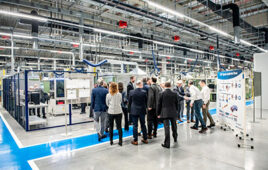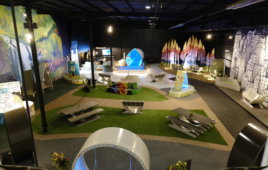The timely receipt of performance data, such a power outputs and vibration signals, helps keep wind farms properly maintained and profitable. Condition monitoring is the discipline of keeping tabs on the machinery in a nacelle, but IT technicians have responsibility for getting data to the trending software and people who will interpret and act on it. Hence, it’s critical to keep the network up and running.
Networks still go down for many reasons. A connector can come loose, construction on site may cut a cable, and cold weather has no respect for electronics in a nacelle. An inoperative network means lost performance and production data, losses that can mount to $50,000 per hour.
Networks that connect turbines together more often than not use a ring topology in which a fiber-optic cable connects all turbines in a long sequence. The fiber-optic cable is critical because it is immune to noise such as EMI from the generator and lightning strikes. As the wind farm grows, separate rings are added to connect new turbines so a wind farm network can be composed of several rings.
Electronic devices with a range of network capabilities, called switches, transmit turbine data to a control center. There are many versions of switches, but in a nutshell, one switch in each turbine controls data flow from it, and another type of switch controls data flow on the ring or network segment. Both are often referred to as managed switches.
Their temperature ratings are important because cold weather is common to most of the U.S. One manufacturer tells of a wind farm network fitted with switches intended for warm indoor use and hence carried a low temperature rating of only 0°C. In their first cold snap, the switches failed and the operator was faced with a costly repair.
Industrial-grade networking devices are intended for harsh environments. In addition, such switches provide deterministic performance, meaning data gets from each turbine to a control center as fast as possible.
Network designers recommend fault-tolerant switches with extended mean-time-between-failure (MTBF) rates. MTBF rates are important because labor expenses are greater in the field than those in the IT world. Even simple switches are expensive to replace in hard to reach locations.
Those who design industrial networks have identified several trends, among them, redundancy, scalability, and support for several fibers. Redundancy refers to duplicate equipment and pathways. For instance, redundant power supplies keeps switches operating should one supply fail. Or, should construction crews sever the network cable, another path lets data get to where it’s needed.
Scalability allows expanding a network as demands change. Most wind farms are built in phases, so the network for the second or third phase should pose no expansion problem. Ring configurations – supporting up to 250 switches per ring – provide this scalability.
Most industrial switches support multi-mode fiber (MMF) and single-mode fiber (SMF). MMF presents a high bandwidth for medium distances, up to 2 km. SMF works well over longer distances, from 20 to 80 km. An ideal network switch should support MMF and SMF on the same unit so that one turbine can be connected to others at different distances without having to purchase separate fiber switches.
With regard to particular protocols, EtherNet/IP network connectivity is capable of exceeding recommended reaction times, 20 ms in some cases. EtherNet/IP, a widely used industrial network, manages standard and safety control on a single network and allows convergence of the turbine’s generator with the business enterprise, providing access to diagnostic data and allowing more accurate and informed decisions. This connectivity also allows for deterministic data exchange at fast intervals and reduces the infrastructure required to support system management activities.
Using a wind-farm management system with EtherNet/IP network connectivity provides wind farm management companies with remote monitoring capabilities. EtherNet/IP uses the Common Industrial Protocol (CIP), which encompasses a comprehensive suite of messages and services for control, safety, synchronization, motion, configuration and information. It allows users to integrate these applications with enterprise-level Ethernet networks and the Internet. Supported by hundreds of vendors around the world and truly media-independent, CIP provides users with a unified communication architecture. WPE
Windpower Engineering & Development
Filed Under: Green engineering • renewable energy • sustainability




